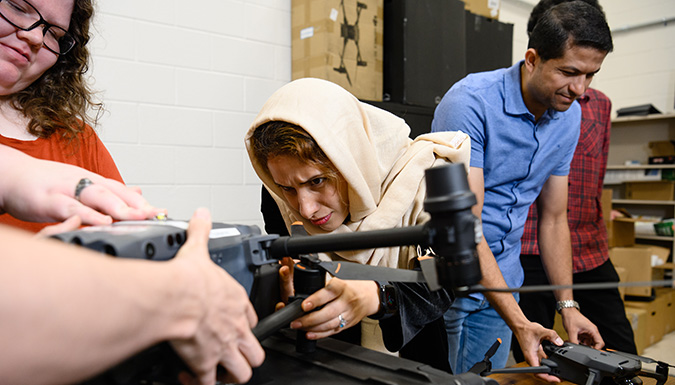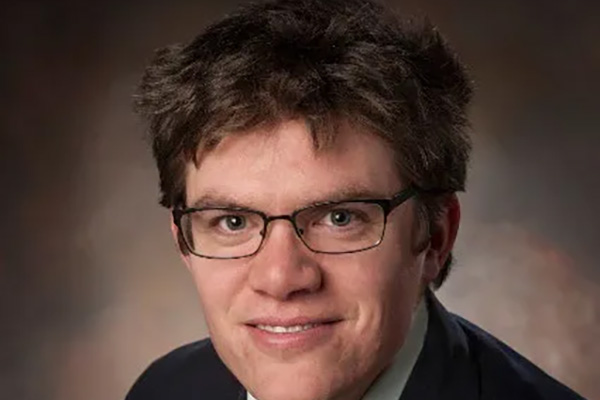Savannah River National Laboratory Collaborations
CONTENT OVERVIEW
Savannah River National Laboratory (SRNL) is a U.S. Department of Energy multi-program research and development center that’s managed and operated by Battelle Savannah River Alliance, LLC (BSRA), of which Clemson University is a core member.
As a member of the BSRA team, Clemson experts provide technical support on environmental remediation, waste management, materials science, computational modeling, advanced manufacturing, cybersecurity and numerous other research topics. Clemson faculty collaborate closely with scientists at SRNL to study solutions to nuclear waste storage, advanced materials, environmental protection and energy security.
The long-standing relationship has not only advanced Clemson’s and SRNL’s research interests, but it has resulted in numerous internships for Clemson undergraduate and graduate students who have had unique opportunities to conduct research with SRNL scientists and Clemson faculty.
Please reach out to Shannon Garrity at garrit5@clemson.edu for any questions.
SRNL Collaboration Day Event
Date: February 3, 2026
Time: 9:00 a.m. to 5:00 p.m.
Location: 230 Madren Center Drive, Clemson, S.C. 29634
What: Panel discussions, research presentations, poster sessions and postdoc and internship opportunities aimed at developing collaborations across the Battelle Savannah River Alliance and Savannah River National Laboratory.
Research Intersections
Clemson University and SRNL share research priorities and strengths in numerous fields:
Advancing Collaborations with SRNL

- 10 undergraduate student scholarships awarded
- 2 graduate students recruited
- 2 research scientists hired
- 7 new faculty hired
- 3 labs equipped and upgraded
- 1 seed funding program created

SRNL R-Initiatives
Clemson University’s R-Initiative programs nurture scholarship and discovery by providing funding opportunities and professional development support for faculty and students. Three R-Initiatives have been created specifically to foster collaboration with Savannah River National Lab. These initiatives will help researchers acquire equipment, as well as recruit, hire and train graduate students, research scientists and postdoctoral researchers. More details on eligibility, funding amounts and periods, proposals instructions and other information are posted online.
View Eligibility & Proposal DetailsJoint Faculty Appointments
SRNL’s Joint Appointment Program provides university faculty opportunities to engage in research and development addressing the nation’s challenges in environmental stewardship, national security and energy transformation. Together, SRNL staff and joint appointees help ensure America’s security and prosperity through transformative science and technology solutions. Joint appointees serve as a bridge between their university and SRNL researchers to deliver the future workforce for the Department of Energy. In addition to Clemson faculty serving as joint appointees at SRNL, scientists at the lab also have joint appointments at Clemson, giving them opportunities to further interact with both faculty and students. Joint appointees serve as a bridge between academic institutions, SRNL researchers and students to deliver the future workforce for SRNL, the Department of Energy and the nation. Joint appointees are listed below. View more information about the SRNL Joint Appointment Program.
SRNL Joint Appointment ProgramFatemeh Afghah
Associate Professor
Clemson University Department of Electrical and Computer Engineering
Afghah’s research interests include wireless communication networks, decision-making in multi-agent systems, radio spectrum management, unmanned aerial vehicle (UAV) networks, security and artificial intelligence in healthcare. Recent work involves autonomous decision-making in uncertain environments, using autonomous vehicles for disaster management and IoT security.
Jake Amoroso

Scientist, Glass and Ceramics
Savannah River National Laboratory
Amoroso’s areas of collaboration focus on materials, glass and ceramic sciences for waste form and energy applications; actinide chemistry and separation sciences; and advanced manufacturing processes.
Sez Atamturktur Russcher

Provost’s Distinguished Professor
Clemson University Department of Mechanical Engineering
Russcher is an expert in computer modeling of engineering systems. Her research is dedicated to the development, application and dissemination of model validation and uncertainty quantification techniques. The main emphasis is on structural dynamics and solid mechanics applications, with a focus on structural systems coupled with other domains.
Ramtin Hadidi

Associate Professor
Clemson University Holcombe Department of Electrical and Computer Engineering
Hadidi’s research focuses on power and energy system modeling and simulation, integration, testing and standardization of distributed energy resources, microgrids control, power system stability studies, controller hardware-in-the-loop (CHIL) and power hardware-in-the-loop (PHIL) testing and co-simulation environment for power systems.
Dale Hitchcock

Senior Scientist, Energy Materials
Savannah River National Laboratory
Hitchcock earned his Ph.D. in condensed matter physics from Clemson University in 2014. At SRNL, Hitchcock’s work has mainly focused on hydrogen isotope interactions with materials. More recently his research has also included projects related to additive manufacturing and mechanical metamaterials.
Brian Powell

Fjeld Professor in Nuclear Environmental Engineering and Science
Clemson University Department of Environmental Engineering and Earth Sciences
Powell’s research focuses on the treatment and storage of radioactive waste and the migration of heavy metals and radionuclides in the environment from natural or engineered systems. He has conducted sponsored research in a wide range of projects dealing with topics of environmental chemistry, radiochemistry, geochemical reaction modeling and thermodynamic database development, evaluation of nanoparticle behavior, subsurface migration of actinides and fission products, and related topics.
Active Research Collaborations
Clemson University and SRNL scientists have initiated numerous research collaborations over the past three years. The list below includes Clemson projects sponsored by Savannah River National Laboratory.
-
Hanford Waste Disposition Enterprise Model
PI: William G. Ferrell Jr., Professor, Industrial Engineering
Summary: This subcontractor will provide expertise, subject matter expert (SME) personnel, including undergraduate and graduate students to support the research awarded to SRNL from the Department of Energy (DOE) - Office of Environmental Management (EM) Hanford Tank Waste Cleanup Research and Development DOE National Laboratory Program Announcement Number: LAB 23-EM001 in March 2024. This research will provide a techno-economic logistics model of the Hanford 200-East and 200-West Tank Farms, waste recovery, consolidation, storage, processing, and disposition. As proposed in response to the funding announcement, this work will require leveraging the expertise across the EM complex – including the Battelle Savannah River Alliance (BSRA). Clemson, a named collaborator on the proposal, is a BSRA partner with recognized and active expertise in the field of radioactive material process logistics and optimization. This subcontract is intended to acquire the state-of- the-art expertise needed for this task and while doing so, create and develop the expertise within SRNL.
-
Efficient Electrochemical Denitration and Caustic Generation (EDCGe) System for Direct-Feed Waste Pretreatment to Accelerate the Hanford Mission and Operations
PI: Jianhua Tong, Professor, Materials Science and Engineering
Co-PI: Dilpuneet Aidhy, Associate Professor, Materials Science and Engineering
Summary: Discovery of high-performance perovskite oxides for denitration and caustic generation electrolyzers. Electrochemical nitrate reduction has attracted significant attention in recent years as it is an alternative, efficient, and sustainable approach to ammonia synthesis.1 In this process, the nitrate source comes from the nitrogen-containing wastewater contaminated by agricultural overfertilization, animal manure, and factory emissions. Therefore, it provides a unique opportunity for completing the nitrogen cycle.2 However, the current nitrate reduction to ammonia electrocatalysts still suffers from the high overpotential requirement, low faradic efficiency, and poor selectivity. While noble metals (e.g., Rh, Ru) show promising potential for electrochemical nitrate reduction, considering the limited resources of noble metals on earth, it is imperative to discover and synthesize high-performance electrocatalysts to limit the widespread use of noble metals. With a nominal formula of ABO3, perovskite-type oxides are outstanding candidates because of their significant functional flexibility in crystal phases and compositions. For example, they can simultaneously accommodate around 90% of the metallic elements in the periodic table, allowing for a wide range of substitution choices for low-cost constituent parts. They can tolerate significant structural defects, such as oxygen vacancies, A or B site cation deficiency, and surface defects, offering numerous possibilities to tune their properties. Furthermore, they can form metal/oxide heterostructure with strong interface interactions through an exsolution strategy, presenting various model catalysts for harvesting superior electrocatalytic activity and stability. Although some progress has been made for perovskite oxides, their performance needs further improvement to meet commercial requirements toward electrocatalytic nitrate reduction to ammonia (e.g., low overpotential, high activity and selectivity, excellent stability). Herein, as shown in Scheme 1, we propose fabricating high-performance perovskite oxides-based electrocatalysts for the electrocatalytic nitrate reduction to ammonia: 1) Defect engineering, which will tune the adsorption/desorption of nitrate/intermediate and hydrogenation behaviors. 2) Crystal phase engineering, which will optimize the intrinsic electron transfer and surface/interface electrocatalytic sites. 3) Heterostructure engineering, which will tailor the electrocatalytic activity and stability through the synergistic effect. The electrocatalytic active Rh, Ru, and Cu would be chosen for doping/exsolution. We expect to enter a new era of high-performance electrocatalysts, which are low-cost but efficient for commercializing nitrate reduction to ammonia.
-
Non-Aqueous 2-D Material Based Hydrogen Isotope Separation-Clemson G-SOW-A-02659
PI: Kyle Brinkman, Department Chair, Materials Science and Engineering
Summary: Ceramic proton conductors are of contemporary interest for protonic solid oxide fuel cells and electrolysis cells for hydrogen production. Recent work has shown that a combination of protonic ceramic materials along with 2-dimensional 2D materials, such as graphene and hexagonal boron nitride (hBN), can provide a means of controlling transport and efficiently separating hydrogen isotopes. To date, studies on 2D material-based hydrogen isotope separation have utilized aqueous conditions, which will be difficult to incorporate into the fusion fuel cycle. The goal of this work will be to investigate a non-aqueous process which can be tailored for a range of fusion fuel relevant conditions. In particular, solid state proton conducting ceramics will be fabricated followed by proton conductivity measurements in hydrogen and deuterium atmospheres.
Hydrogen isotope separation is a critical technology for a commercially viable fusion power plant. Traditional techniques for hydrogen isotope separation are energy intensive, require low temperatures, a large footprint, or some combination. In prior work, SRNL led an effort outlined in patent application US 2023/0017076 A1 (Jan 19th, 2023) titled “hydrogen isotope separation systems” where Clemson utilized protonic ceramic membranes in conjunction with 2D graphene layers to develop and test a membrane system. At this stage, further attention is required on materials development and testing. This project will capitalize on the combined expertise of the Clemson and SRNL investigators.
-
Computational Alloy Development for Additive Manufacturing
PI: Dilpuneet Aidhy, Associate Professor, Materials Science and Engineering
Summary: Support SRNL in the design and development of tungsten-based high entropy alloys that have high ductility for fusion reactor first-wall component. Atomistic calculations will be used to identify tungsten-based compositions that would have high ductility which can then be 3d-printed by SRNL. In his regard, electronic structure calculations will be used to understand the physics of composition-ductility correlation, and machine learning will be used to enable predictions in the large compositional phase space. Additionally, the optimal mixing zone lengths between pure tungsten and pure vanadium or vanadium-44 when additive manufacturing (3D-printed) will be predicted and experimentally verified. Dependent on mutual party approval documented via email, additional scope may include other property analysis of HEAs and/or alloy mixtures, and scope may extend into a second year.
SRNL has unique capabilities to experimentally synthesize novel materials for first wall materials, which include high entropy alloys (HEAs) and functionally graded alloys that are being considered for this application. However, there is a large compositional space in these alloys that can’t be experimentally tested. Computational modelling is critical to identify ductile alloys that can be synthesized. Clemson University will perform the computational modeling to understand the mechanistic reasons for ductility and develop machine learning methods to predict new, ductile alloys and ideal ways to join dissimilar alloys.
-
EM Enterprise System Planning: Clemson University - Task Order Proposal Request #707991
PI: William G. Ferrell Jr., Professor, Industrial Engineering
Summary: SRNL has identified a vision for the EM Enterprise Platform to help direct the environmental cleanup across the multiple DOE sites in the United States. Achieving this vision will require significant efforts by many organizations in a coordinated fashion. Clemson is pleased to participate in this effort and will fully support SRNL in planning and executing future tasks that will be defined. Clemson can support logistics and supply chain related tasks with some of all of the following activities depending on the nature and scope of the specific future task.
- Assign students to the project who will develop models of the logistics and/or supply chain systems. The team will identify and obtain/generate model inputs, develop/validate the models, and analyze outputs to meet customer needs. It is understood that “what if” scenarios are highly desirable so satisfying this desire will be considered in all research efforts.
- Coordinate and collaborate with SRNL staff, staff at other national laboratories (e.g., Sandia National Lab), and other SMEs as appropriate during the research efforts. Areas where collaboration and coordination would be important include but are not limited to model development, obtaining/generating input data, analyzing model outputs, and presenting information in a way that is consistent with the expectations of users.
- Assist SRNL as needed to develop and provide appropriate instructional materials so the models can be modified and executed by staff with reasonable technical skills in the modeling and solution techniques.
In short, the Clemson PI and a team of students will support the logistics and supply chain systems modeling effort associated with constructing the EM Enterprise Platform. This proposal pledges to support to SRNL in these planning efforts and when specific tasks are developed in the future with associated funding, a commitment to support the execution of tasks if the technical skills to be successful reside within Clemson.
-
SRNL Glass Database Development and Testing - PRE-REQ-2022-00716
PI: Dilpuneet Aidhy, Associate Professor, Materials Science and Engineering
Co-PI: Kyle Brinkman, Department Chair, Materials Science and Engineering
Summary: The U.S. Department of Energy (DOE) utilizes vitrification technology for the safe and permanent immobilization of legacy radioactive wastes resulting from nuclear materials production. DOE vitrification facilities employ complex glass property-composition models to ensure processability of waste streams and acceptability of the final glass products. Large amounts of glass property- composition data have been produced by SRNL, PNNL, the Catholic University of America (CUA), and other institutions in support of the development, validation, and continuous improvement of these models. The data exist in multiple repositories and there is currently no way to access the data to support continuing studies.
The existing and initial datasets from which a larger, unified Nuclear Waste Glass Database has been established are listed in “Summary of Information Available and Recommendations for a DOE Complex-Wide Waste Glass Database” [1]. In this document, a framework is described for consolidation of the data into a single database, which was initiated by SRNL and Clemson University in FY23. Recommended attributes of the consolidated database have been included, including quality assurance, the user interface, and means for updates and maintenance.
Now that the initial database framework has been constituted, the Team will continue to make additions of data to the database while also establishing a methodology of computational methods with which we shall test the database’s accessibility as well as utilize computational materials science to glean information from the database about the nature of nuclear waste glasses. The Team may also use bootstrapping methods with additional glass databases (e.g., SciGlass) to amend the glass compositional spaces being explored.
-
SOW # G-SOW- 02554: High Entropy Alloy Hydrogen Permeation Modeling
PI: Dilpuneet Aidhy, Associate Professor, Materials Science and Engineering
Summary: Support SRNL in the development of High Entropy Alloys (HEAs) for use in hydrogen permeator applications. In particular this support will involve the use of DFT modeling coupled with data science to predict alloy compositions with high hydrogen isotope permeability. SRNL is currently working to develop hydrogen isotope diffuser materials based on high entropy alloys (HEAs) that have been reported to have hydrogen permeabilities comparable to state-of-the- art palladium silver diffuser alloys. Importantly the alloys will contain no noble metals which will alleviate supply chain concerns and significantly reduce costs. The proposed HEAs will also be easier to join to stainless steels or other common process alloys than Pd:Ag alloys which would simplify the fabrication of permeators.
-
Task Order Proposal SRNL Glass Database, SOW # 623879 ProPoint# PRE-REQ-2022-000716
PI: Dilpuneet Aidhy, Associate Professor, Materials Science and Engineering
Summary: Nuclear waste glasses have been extensively studied for waste immobilization with a range of compositions and resulting properties. Clemson has several past and current projects on glass and ceramic materials for waste form immobilization. Clemson also has experience and expertise with database construction for use in computational materials science initiatives. This work will use background materials science knowledge in glass/ceramic waste form materials along with database design construction to create a database structure and user interface of use for SRNL scientists studying materials properties and performance.
DOE uses vitrification as an immobilization strategy for legacy nuclear waste. Currently large amount of glass property composition data exists from DOE and partners in a variety of formats and platforms which make it difficult to access and validate existing performance models. This project will capitalize on the combined expertise of the SRNL investigators and the Clemson University Subcontractor to create a unified database structure for use in studying materials properties and performance.
Centers and Facilities
Clemson has numerous top-notch facilities and programs to support research and workforce development and SRNL (non-exhaustive list):
- The Center for Nuclear Environmental Engineering Sciences and Radioactive Management (NEESRWM)
- Dominion Energy Innovation Center
- Electron Microscopy Facility
- Center for Advanced Manufacturing (CAM)
- Center for Workforce Development (CUCWD)
- Palmetto High Performance & Research Computing Center
- Clemson Artificial Intelligence Research Institute for Science and Engineering

